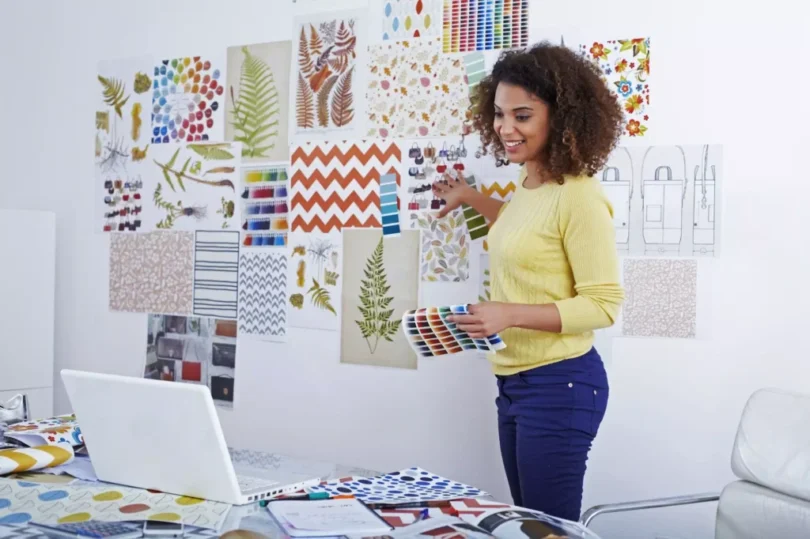Interior design is one of the most rewarding and creative careers today, with demand soaring in both residential and commercial sectors. As people spend more time at home and businesses focus on creating better environments for their employees, interior designers are in high demand. Whether it’s designing a cozy home, a modern office, or sustainable spaces, interior designers play a key role in shaping the way we live and work.
If you’re thinking about becoming an interior designer, this blog post will guide you through everything you need to know, from understanding the different roles in the field to how to get started, salary expectations, and the skills you’ll need to succeed.
What Do Interior Designers Do?
Interior designers are responsible for making spaces functional, stylish, and aesthetically pleasing. They work closely with clients to understand their needs and transform spaces—whether it’s a home, office, or commercial space. Interior designers can work on a variety of projects, from residential homes to retail stores, restaurants, and even large corporate offices.
Key Roles in Interior Design
1. Residential Interior Designer
Residential interior designers focus on designing private homes. They work with homeowners to create spaces that reflect personal style while ensuring functionality and comfort. This can include everything from layout planning to furniture selection and decor.
Skills Needed: Creativity, attention to detail, a deep understanding of color schemes, furniture, and textiles.
2. Commercial Interior Designer
Commercial interior designers work on larger projects, such as offices, retail stores, and public spaces. They are skilled at designing spaces that not only look great but also meet the needs of businesses, focusing on functionality, branding, and flow.
Skills Needed: Knowledge of space planning, understanding of business needs, and project management skills.
3. Lighting Designer
Lighting designers specialize in the lighting aspects of interior design. They plan and implement lighting systems to enhance the mood and functionality of spaces. Their work is crucial for both aesthetic appeal and the practical needs of a room.
Skills Needed: A strong understanding of lighting technology, design, and how lighting affects mood and functionality.
4. Sustainable Interior Designer
With a growing emphasis on eco-conscious choices, sustainable interior designers are in high demand. They focus on using environmentally friendly materials, energy-efficient designs, and sustainable practices to create eco-friendly spaces.
Skills Needed: Knowledge of sustainable materials, energy efficiency, and green building practices.
Why Interior Design is Trending
Interior design is trending for several reasons, and the growing need for functional, beautiful, and eco-friendly spaces has never been more apparent.
1. Increased Time at Home
With the rise of remote work and more time spent at home, people are focusing more on creating spaces that are not only comfortable but also reflect their personal style. As a result, there’s a rising demand for residential interior designers to help people transform their living spaces.
2. Improving Workplace Environments
As businesses prioritize employee wellness and productivity, there’s a growing need for commercial interior designers who can create inspiring and functional office spaces. Companies are investing in modern, flexible workspaces that promote collaboration and creativity.
3. Sustainability Focus
As consumers become more environmentally conscious, sustainable interior design has become a top priority. Designers who can integrate green building practices and eco-friendly materials into their projects are highly sought after. Sustainability-focused interior design is a growing trend as people seek energy-efficient, environmentally responsible living and working environments.
4. Social Media Influence
Platforms like Instagram and Pinterest have transformed the way people approach interior design. People now look for “Instagrammable” spaces and are constantly seeking design inspiration online. This has increased the demand for interior designers who can create visually appealing and shareable environments.
How to Become an Interior Designer
If you’re considering a career in interior design, here’s how to get started:
1. Education & Training
While a formal education is not always required, earning a degree in interior design or a related field can give you a competitive edge. Many colleges and universities offer interior design programs, and there are also accredited certification programs for those who wish to specialize in areas like sustainable design or lighting.
For those who prefer a more hands-on approach, there are numerous online courses and workshops that can help you learn specific design skills and tools.
2. Gain Practical Experience
Interior design is a skill that improves with experience. Consider internships or apprenticeships with established interior design firms or work on small projects to build your portfolio. Volunteering to redesign spaces for non-profits or family members can also help you get real-world experience.
3. Build a Strong Portfolio
Your portfolio is essential in this field. Start by showcasing your best work, whether it’s through photos of completed projects or conceptual designs. As a beginner, you might start by documenting small projects or redesigning spaces in your own home. Over time, your portfolio will grow, helping you attract clients or employers.
4. Network
Interior design is a highly collaborative field, so building a network of professionals in the industry—such as contractors, architects, and other designers—is crucial. Attend design events, join professional organizations like the American Society of Interior Designers (ASID), and actively engage in online communities to connect with other interior designers and potential clients.
5. Stay Current
The world of interior design is constantly evolving, with new trends, technologies, and materials emerging all the time. Stay current by following design blogs, attending industry conferences, and subscribing to design magazines. This will help you keep up with the latest trends and provide innovative solutions to your clients.
Salary Expectations for Interior Designers
Salaries in interior design can vary depending on experience, location, and the type of design work you specialize in. Here’s a breakdown:
- Residential Interior Designer: The average salary is around $50,000 to $75,000 annually. High-end designers working with wealthy clients can earn more.
- Commercial Interior Designer: Commercial designers can earn between $55,000 and $80,000 per year, depending on the scope and size of the projects they manage.
- Lighting Designer: Lighting designers typically earn between $50,000 and $75,000 annually, depending on their expertise and experience level.
- Sustainable Interior Designer: Those specializing in sustainable design can expect to earn between $60,000 and $90,000 per year, as eco-conscious design is increasingly in demand.
Freelancing or owning your own interior design business can offer higher earning potential as you build a solid reputation and client base.
Interior design is a growing field with diverse opportunities for creative professionals. Whether you’re drawn to residential, commercial, or sustainable design, there’s a place for you in this exciting industry. By gaining the right education, building a strong portfolio, and staying connected with industry trends, you can carve out a successful career in interior design.
If you have a passion for creating beautiful, functional spaces that improve people’s lives, now is the perfect time to pursue a career as an interior designer. The demand for talented professionals has never been higher, and your design journey can begin today.






